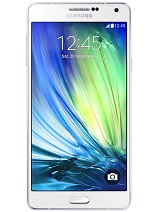Introduction
It's not every day we have a true record holder in our hands, and that's exactly what we were getting ready for waiting for the vivo X5Max to arrive. The slimmest smartphone in the world for more than six months now, the 4.75-mm X5Max snatched a crown that had been tossed between the Gionee Elife S5.1 and the Oppo R5, each of them holding it for a fleeting month or so.
You can then imagine our disappointment when it turned out we have the global version, which is "only" the third-slimmest phone in the world. A fraction of a millimeter thicker than the China model, the vivo X5Max is an extraordinarily slim device nonetheless, most certain to impress with a profile you wouldn't normally attribute to a smartphone.
It really looks almost like a planar object, its two dimensions much greater that the third, so to speak, in math terms.
In terms of hardware, the X5Max is less exciting, relying on the now ubiquitous midrange Snapdragon 615, coupled with the equally commonplace 2GB of RAM. It doesn't skimp on features though sporting a 13MP primary camera behind a fast f/2.0 lens, as well as a 5MP front-facer.
A 5.5-inch FullHD display helps keep thickness in check thanks to the Super AMOLED tech, while providing the signature colors and contrast. The extra 0.33mm thickness have allowed designers to fit a larger-capacity battery, though it still looks underpowered on paper for its screen size.
Key features
Dual-SIM dual-standby capability, microSD slot shared with second SIM
5.5" 1080p Super AMOLED capacitive touchscreen, 401ppi
Octa-core Cortex-A53 CPU (4x 1.5GHz plus 4x 1.0GHz), 2GB of RAM, Adreno 405 GPU; Qualcomm Snapdragon 615 chipset
13MP autofocus camera, f/2.0 lens, single-LED flash; HDR, Panorama, Night, Pro mode with long exposure (up to 32s)
1080@30fps, 1/4x slow motion video recording, 10x speed timelapse
5MP front camera, f/2.4, 720p video recording
16GB of built-in storage
Cat. 4 LTE (150/50Mbps); dual-band Wi-Fi a/b/g/n; Bluetooth 4.0; GPS with A-GPS; microUSB
2,300mAh battery
Standard 3.5mm headphone jack
5.5" 1080p Super AMOLED capacitive touchscreen, 401ppi
Octa-core Cortex-A53 CPU (4x 1.5GHz plus 4x 1.0GHz), 2GB of RAM, Adreno 405 GPU; Qualcomm Snapdragon 615 chipset
13MP autofocus camera, f/2.0 lens, single-LED flash; HDR, Panorama, Night, Pro mode with long exposure (up to 32s)
1080@30fps, 1/4x slow motion video recording, 10x speed timelapse
5MP front camera, f/2.4, 720p video recording
16GB of built-in storage
Cat. 4 LTE (150/50Mbps); dual-band Wi-Fi a/b/g/n; Bluetooth 4.0; GPS with A-GPS; microUSB
2,300mAh battery
Standard 3.5mm headphone jack
Main disadvantages
Dated Android KitKat 4.4.4
No FM radio or NFC
Another in a long line of designer Chinese smartphones, the vivo X5Max relies on the proven formula of striking looks and all-round capable hardware. We don't expect it to outperform flagships, but its priorities lie elsewhere and the X5Max scores high on style. While it will certainly be on the short list of anyone looking to stand out, the smartphone needs to prove it has enough substance to match its upmarket exterior.
Controls and handling
The vivo X5Max relies on capacitive buttons in the bottom bezel for navigation in a Menu/Home/Back arrangement. Above the display there's the earpiece in the middle with the 5MP front camera to the left and the proximity/ambient light sensor on the other side.
The back features the 13MP camera in the top left corner, joined by its single-LED flash and a secondary mic midway between the two. The speaker mesh is mostly a design element, as the actual speaker is no more than a quarter of its length and is situated in its right end.
The right side is home to the volume rocker and the power button towards the top and the card slot closer to the bottom. The card tray is made of metal as well, and despite its miniscule thickness is quite sturdy. It will take a micro-SIM and a microSD card or a micro- and a nano-SIM card, but never all three at the same time.
The left side is completely bare.
5.5 inches of Super AMOLED goodness
It you want thin, AMOLED is the way to go, and in the case of the vivo X5Max it's a 5.5-inch FullHD panel. That results in 401ppi, which is more than enough for sharp text.
The panel is a fine representative of the MOLED tech and offers plenty of punch and wide viewing angles, though it does exhibit a greenish tint when viewed from the side.
There are no color adjustments to be found in settings, nor is there a glove mode.
Out microscope shot revealed the expected diamond pentile arrangement, with twice as many green subpixels as any other color.
Connectivity
For starters, the vivo X5Max is a dual-SIM dual-standby device. One of the cards gets the full 2G/3G/4G treatment with multiple bands each, while the other is limited to 2G. You can set which one is which in the settings and the micro/nano SIM slots mean you can use either form factor as your main card. You'd need to go microSIM though if you value the memory expansion, as the microSD slot is shared with the nanoSIM.
The smartphone has dual-band Wi-Fi 802.11 a/b/g/n with DLNA, Wi-Fi direct and hotspot support. There's Bluetooth v4.0, but no NFC or FM radio.
There's GPS with A-GPS for precise positioning over cellular, but for all we know, there's no GLONASS to utilize Russian satellites.
The microUSB 2.0 port supports USB On-The-Go and lets you attach peripherals. A standard 3.5mm jack completes the wired connectivity package.
Battery life
Slim phones typically struggle in this very part of our test for very obvious reasons - less space means less battery capacity. The thinnest 4.75mm vivo X5Max comes with a modest 2,000mAh cell, but the version we have for review is a bit better equipped with a 2,300mAh unit.
To put it simply, the X5Max amazed us in terms of its battery performance. It posted impressive scores across the board, not only considering its screen diagonal and battery size, but also in absolute values. Standby endurance, which is not included in the scorecard, is about 11 full days with a single SIM, and a day less with a second SIM inside. Call times on a 3G network are more than 17 hours, well above average.
Moving on to on-screen activities, the smartphone is good for nearly 11 hours of video playback - it can easily last you a transatlantic flight with constant movie watching.
Web browsing is the most taxing on the battery, but it also shows a marked difference between the stock browser and the also available Google Chrome. While the vivo offering manages a little over 6 hours, Chrome is substantially more efficient and with it the X5Max scored upwards of 9 hours of web browsing.
Synthetic benchmarks
We've lost count of the number of devices, utilizing Qualcomm's upper-midrange Snapdragon 615 chipset (though a quick free-text search in our Phone Finder returned 36 entries from our database alone).
As you probably know, the chipset comes with a dual quad-core processor setup and in the case of the vivo X5Max the two clusters of Cortex-A53 cores are clocked at 1.5GHz and 1.0GHz for power and efficiency respectively. There are 2GB of RAM on board, when we're seeing a gradual move towards 3GB even in the midrange, though the real-life benefits of this are still debatable.
We've already had the opportunity to test a bunch of similarly equipped devices and had a general idea what to expect. We have picked out the more-popular of those and it turns out implementing and utilizing the said Qualcomm chipset is still a challenge for a lot of vendors. Results vary greatly, but a lot of that can also be attributed to custom OS overlays.

For a broader comparison we have also thrown in a few devices that you can pick up for around the same price as the vivo - the LG G3, HTC One E9+, Samsung Galaxy E7 and the Asus Zenfone 2. Others like the Huawei P8 are simply there because of their stylish exterior and design - a major selling point for the vivo X5Max.
Final words
The third slimmest smartphone in existence, the vivo X5Max turns out to be a multidimensional performer. Sure, its claim to fame lies in its upmarket design, which we need to be really picky to find fault with. The execution is top-notch as well, and the smartphone is working hard to justify its price tag, though of course you need to be willing to accept the premise that style and build are worth a premium.

Believe it or not, this nearly paper-thin smartphone excels in battery life, of all areas. If you steer clear of the proprietary browser, you're in for a pleasant surprise in terms of uptime. An endurance rating around the 70-hour mark is the summary of a balanced performance in all areas, both active on-screen time and standby.
The 5.5-inch FullHD Super AMOLED is another excellent performer scoring high in the brightness department, for a Super AMOLED that is. It's sharp, has lively colors and only exhibits a slight green tint when viewed from an angle.
Funtouch OS is perhaps a little controversial. Some will embrace the fresh-looking Android skin with its customization options and nifty gesture controls. Others won't be able to get over how disorganized it is and the strong iOS influence will certainly bother Android purists. It may also be hard to swallow the fact that you're buying into a year-old OS release.
Granted, hardware performance isn't the X5Max' strong suit. Vivo apparently held back a little when tweaking the chipset and that may have something to do with the great battery numbers, but we don't see much fault with such a bias, certainly not in the case of the X5Max.
The 13MP camera creates images with a lot of detail, but also plenty of noise, though we appreciate the conservative approach to noise-suppression. True-to-life colors and dependable exposure round up a good overall experience in terms of stills, while 1080p videos are decent at best.
Key test findings:
- Premium looks, amazing thinness, quality materials and solid build
- Sharp 5.5-inch FullHD AMOLED display, vibrant colors, good viewing angles with a slight green tint, above average AMOLED brightness
- Dual-SIM dual-standby capability, otherwise average connectivity package
- Excellent battery life: 71-hour rating with a single SIM inside and stellar individual numbers
- Quirky Funtouch OS takes a bit of getting used to, but is rich in customization and added functionality; the bundled app package only covers the basics, but does it well; the gallery has a rich editor, video player ran everything we threw at it, music player is straightforward and functional
- Raw performance fails to impress, likely due to poor software optimizations
- Very good photos with nice detail and good color rendering, but there is a lot of noise
- Okay 5MP selfie cam, images a touch too soft
- Video recording is passable, but nothing memorable
The Oppo R5 is among the most obvious rivals of the vivo X5Max. Fractions of a millimeter are for bragging rights only, and where it matters, the smaller-screened 5.2-inch R5 loses by a country mile - for every full battery charge on the X5Max you'll need to do two on the R5, and no fast charging tech will offset that.
Then there's the Oppo R7, a more balanced offering where battery endurance is not such a limiting factor. You'd be sacrificing even more screen real estate here, as the R7 is only 5.0 inches in diagonal. We'd be hard-pressed to pick the best of these three in terms of build and finish, but there's something about the 2.5D glass of the R7, which may tip the scales in its favor.
The Samsung Galaxy A7 has a marginally smaller footprint, and at 6.3mm is not exactly thick either. It's also substantially lighter and has a slightly better battery life, even on top of the already excellent X5Max. The Galaxy A7 has already gotten the Lollipop update, while the X5Max may never live to see one.
The LG G Flex2 is being heavily discounted in many parts of the world, despite the fact that it's rocking proper flagship hardware. You could easily snatch one for even less than the X5Max, and the dramatically curved 5.5-incher has a lot of appeal for the style-conscious too. The G Flex2 has a superior OIS camera, laser autofocus and 2160p video recording.
The Meizu MX4 Pro is worth a look as well. Yes, it's roughly twice as thick, but it's cheaper, its 5.5-inch display has QHD resolution, its camera can shoot 4K video, and it will significantly outlast the X5Max if you're mostly into web browsing. It also has a fingerprint sensor. But did you go on reading after we said twice as thick? The newly released MX5 is in the picture too, and it's thinner, while retaining most of its predecessor's virtues, save for the QHD resolution.
Older flagships are also within reach of the buyer ready to pay the vivo X5Max' asking price. The Sony Xperia Z2 is one that comes to mind. Although two-generations-old already, the Z2 can easily outperform the X5Max, and has environmental sealing and better battery backup. It does have a smaller screen though, and is just another mainstream device, unlike the X5Max.
There's a lot to like about the vivo X5Max, in fact it must be one of the more pleasant surprises recently. It can't outgrow the limitations of its chipset paired with less than perfectly optimized software, and Funtouch has a long road to maturity. But it has a beautiful display, it shoots fine images and scores high in the most unexpected area, battery life. The X5Max is another fine phone to help overcome prejudice against Chinese designs but also one that argues premium looks do not necessarily imply usability compromises.
First up, we have the raw CPU performance test with GeekBench 3, which should be straight-forward enough. The eight Cortex-A53 cores inside the MSM8939 are by no means a bit-churning powerhouse, but have definitely proven themselves more than adequate in a lot of current devices. Yet, the Vivo X5Max doesn't seem to utilize them to their full capacity. As far as raw calculation goes, the handset falls behind most similarly equipped devices. Like we said, most of the performance drop can be attributed to poor software optimization and the custom OS. Still, we can see that ZTE has managed to do even worse with the Blade S6, powered by the same chipset.










.jpg)


.jpg)





Hi, thank you very much for help. I am going to test that in the near future. Cheers
ReplyDeleteMoto G3 Case